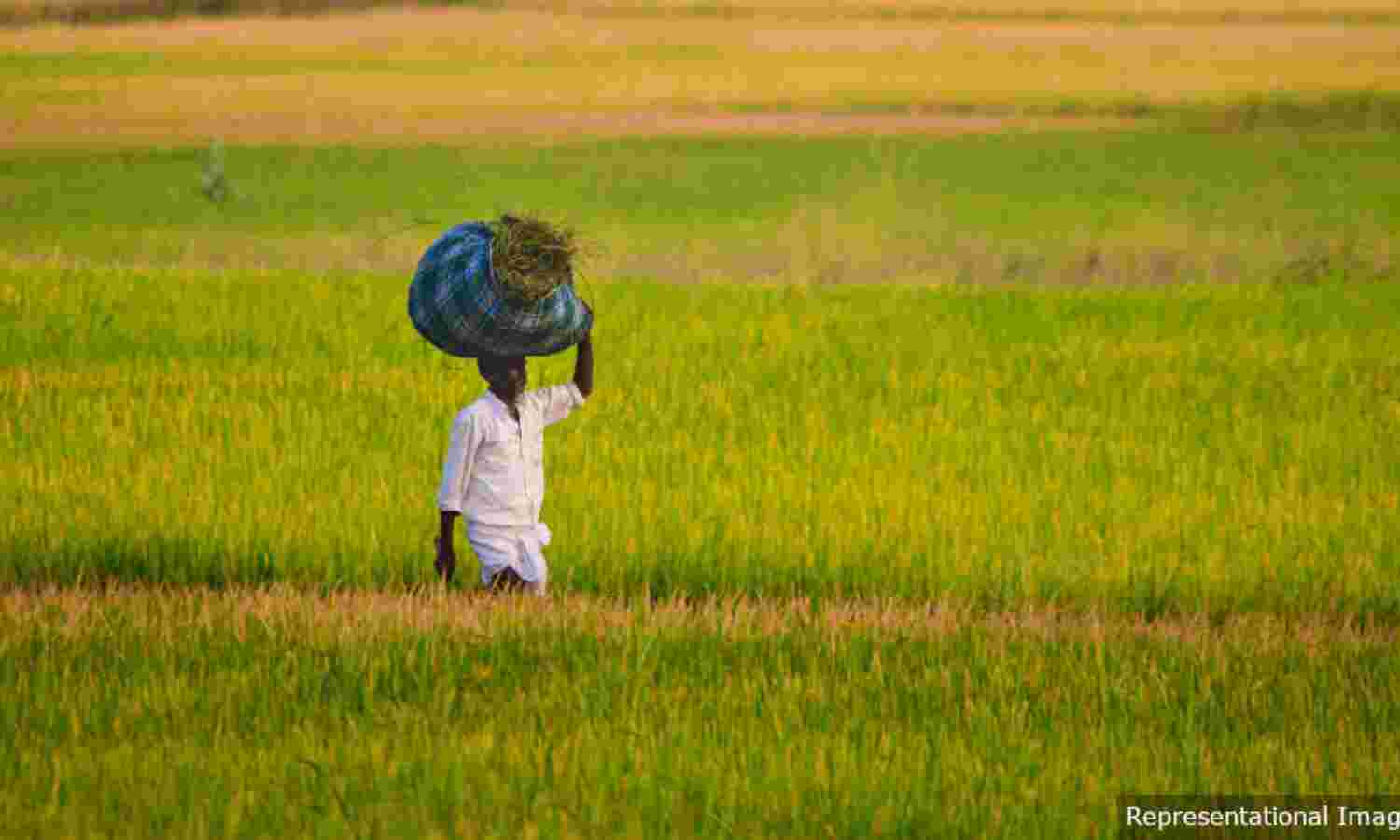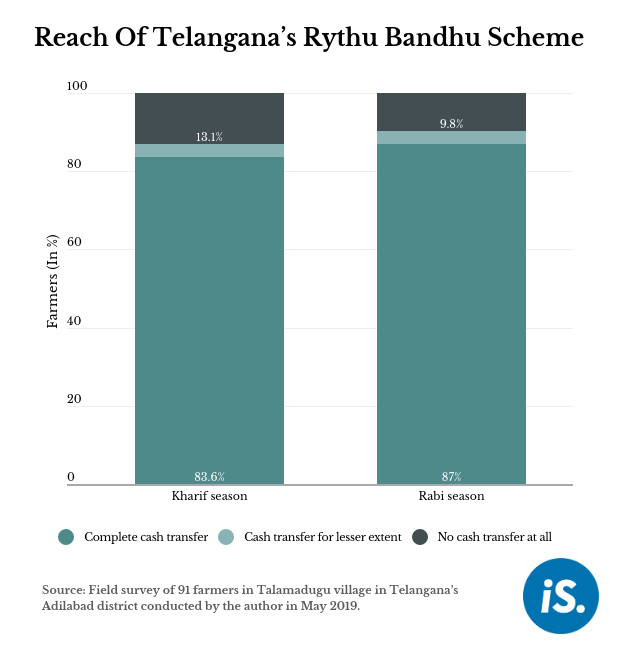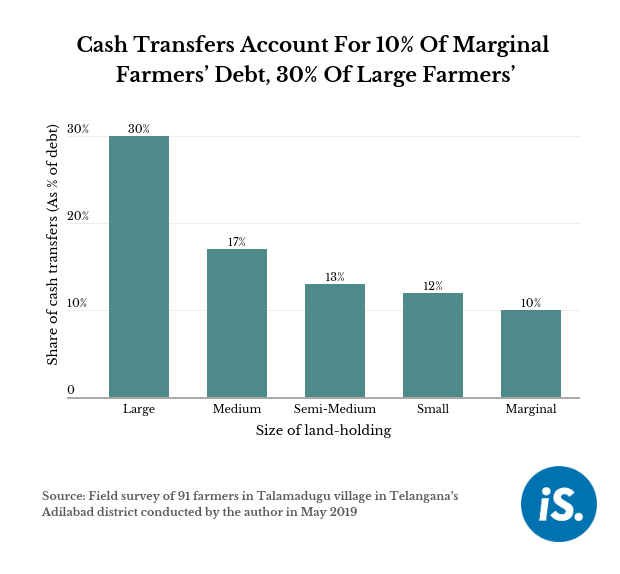Why Cash Transfers Cannot Replace Structural Reforms In Agriculture

New Delhi: With the launch of the Rajiv Gandhi Kisan Nyay Yojana (RGKNY) on May 21, 2020, Chhattisgarh became the sixth Indian state in two years to initiate a direct cash transfer scheme for farmers. The scheme aims to supplement the income of the state’s 1.9 million farmers by Rs 10,000-Rs 13,000 per acre of land owned.
Cash transfers for COVID-19 relief and stimulus are also gaining salience, with the Centre announcing frontloading of PM Kisan payments. How effective is this increasingly popular direct transfers approach? One way to assess this is to analyse the impact of India’s first cash transfer scheme for farmers, Telangana’s Rythu Bandhu Scheme (RBS), launched in May 2018. Both RBS and the Rs 5,700-crore RGKNY are alike in that both define cultivators in terms of land ownership.
The Telangana scheme achieved an extensive reach of up to 79%, but 76% of farmers did not use the amount disbursed for agricultural activities in the rabi season, undermining its objectives, showed the findings of a field survey conducted by this writer during May 2019. The survey to evaluate the functioning of RBS also suggested that by and large, farmers with large landholdings garner most payments, while to marginal and small farmers, the payments act as a safety net in the absence of access to institutional agricultural provisions, rather than as a liquidity stimulus.
Other states that have implemented cash transfer schemes for farmers are Odisha, Jharkhand and West Bengal in 2018 and Andhra Pradesh in 2019. Of the six states running such schemes, only Odisha and Andhra Pradesh have specifically targeted small and marginal farmers, cultivators and landless agricultural labourers. The RGKNY has also set an additional metric of 15 quintals of crop yield per acre of farmland, to calculate payments to farmers.
Agrarian distress has been chronic and widespread in India for decades now. In the last six years, the annual growth rate in real terms in the ‘Agriculture and Allied sectors’ category has remained static, according to the Economic Survey 2019-20.
As measures such as loan waivers and Price Deficiency Payments (PDP) failed to provide any relief to farmers, both the Centre and the states have increasingly embraced direct cash transfers--not only as one of the main tools for supporting farmer welfare but also as a response to the chronic agrarian distress.
However, economists have been highlighting the need to focus on strengthening structural capacities such as enhancing storage, warehousing and market infrastructure and assuring a supply of formal credit.
Higher coverage, lower efficiency
Telangana launched RBS, a farmers’ ‘investment support’ scheme offering Rs 4,000 per acre per season (later increased to Rs 5,000), with the aim of enhancing liquidity in the sowing season to increase agricultural productivity and reduce indebtedness.
Soon, other states started supporting farmers through cash transfers; and RBS went on to inspire the flagship PM-KISAN scheme at the central level. Under the PM Kisan Scheme, income support of Rs 6,000 per annum is provided to all eligible farmer families across the country in three equal instalments of Rs 2,000.
Based on a field survey of 91 farming households (including 30 landless tenant households) conducted in Talamadugu village of Adilabad district, RBS was assessed on primarily five grounds: reach, use, sufficiency, ability to provide relief from indebtedness, and impact on tenant cultivators excluded from its purview. The survey was conducted in May 2019--exactly a year after the scheme’s launch--and gives insight into what works and what does not in cash transfer schemes.
One of the reasons why some economists prefer cash transfers to loan waiver/minimum support price (MSP) is because of its reach. Both loan-waivers and MSP cannot be availed by smaller farmers because of their lack of access to institutionalised credit and agriculture markets, in addition to their production outputs being smaller, economists have suggested. Cash transfers, they countered, have wider reach.
The field survey confirmed these conclusions to an extent. Of all the landowning farmers surveyed, around 79% got the complete cash transfer amount they were due under RBS for both the seasons. Smaller farmers, especially those from SC and ST communities who received the transfer, found it useful as a safety net because other public institutional agricultural measures proved inadequate.
We asked Gontimukkalla Ganganna, a marginal farmer from the Scheduled Caste (Madiga) community who cultivates two acres of land, if he would want to receive income support if the MSP for cotton was raised to desired levels. “Yes and no,” he replied. “We need Rythu Bandhu anyway because our output is small and we don't sell our produce to the Cotton Corporation of India. We directly sell to the private traders who generally buy the cotton from us at a rate less than the MSP. Private traders don't give us a good rate knowing we are small farmers. Rythu Bandhu acts as a safety net. If we can sell our crops at the MSP, we won’t need Rythu Bandhu. But at this point, it is helpful.”
In addition, at least 45% of the farmers surveyed said they could not sell their crops at MSP and in general, did not have access to it. Accordingly, a majority of these farmers (70%) preferred to continue receiving income support even after being given the option of higher price support. (The question asked was if they would want cash transfer notwithstanding a desired increase in MSP).
The farmers argued that they never got to sell their crops at MSP anyway and that traders discriminated on the basis of caste. Others argued that the quality of land assigned to them by the government was so poor that they could hardly get any yield. For these farmers, cash transfers proved more effective than MSP.

Put to other uses
One of the most fundamental determinants of the efficiency of an “investment support” scheme is how the cash transfer is utilised by the farmers. Of the 53 farmers who had received the cash transfer in the kharif season (around the monsoon, the primary cropping season in Telangana), only around 68% of the farmers spent some or the entire portion of their cash transfer on agriculture, while 32% spent it on other uses, the survey showed, leading to fiscal wastage.
This was observed all the more in the rabi season (winter cropping season): Up to 76% of all the farmers surveyed did not undertake any cultivation in this season and they used the cash transfers for meeting more immediate needs such as household expenses, daughter’s marriage and harvesting of kharif crops.
The survey concluded that a crucial parameter for the success of such schemes is the timing of the disbursal of funds. If funds are disbursed during the initial sowing season, there is a high chance of the cash transfer being used for sowing, early stages of cultivation, purchase of fertilisers and so on. But if the funds are disbursed after the early weeks of cultivation, the likelihood of the scheme meeting its objective reduces.
Economist Mihir Shah calls this the “fallacy of misplaced concreteness”, arguing that the “problem is not that of transfer of money, the problem is that of translation of that money into concrete assets”.
Exclusion of tenants
At the launch of the RGKNY, chief minister Bhupesh Baghel said that 90% of the scheme’s beneficiaries would be small and marginal farmers, a majority of them from the Scheduled Castes (SC), Scheduled Tribes (ST) and Other Backward Classes (OBC). In Telangana, 86% of landholdings were with small and marginal farmers. But on average, a “large” farmer in India has 45 times more land than a “marginal” farmer, as IndiaSpend reported in May 2016, implying that cash transfer schemes based on land-ownership with no ceiling limit are likely to benefit land-owners with large land holdings more. This was noticed even in the study.
For analysis, we used the National Sample Survey report number 576, 2012-13 in order to gauge what percentage the cash transfer constituted of the household income of the farmers surveyed. The report contains details of the average monthly income and consumption expenditure per agricultural household for each size and class of land possessed. Extracting the data for the whole of Telangana state and making a few computational changes, yielded the following results:
| Cash Transfers Account For 16% Of Marginal Farmers’ Annual Income, 174% Of Large Farmers’ | |||||
|---|---|---|---|---|---|
| Type(Household Level) | Monthly Income as of 2013 (In Rs) | Annual Income Adjusted for Inflation (In Rs) | Average land-holding size (In acres) | Estimated cash transfer (In Rs)* | Share of Cash Transfer in Annual Income (In %) |
| Marginal | 4753 | 63,710 | 1.25 | 10000 | 16% |
| Small | 6290 | 84,311 | 3.75 | 30000 | 36% |
| Semi-Medium | 7600 | 1,01,870 | 7.5 | 60000 | 59% |
| Medium | 13040 | 1,74,788 | 17.5 | 140000 | 80% |
| Large | 8593 | 1,15,181 | 25 | 200000 | 174% |
Source: Author’s calculations, based on National Sample Survey report number 576, 2012-13*Based on cash transfer of Rs 8,000 per acre.
The last column shows the regressive design of the scheme in terms of its share of annual income: The cash transfer formed the smallest percentage (16%) of the annual income for marginal households and largest (174%) for large households. Households with larger land-holdings seemed to benefit much more from cash transfers.
This also holds true of debt coverage, with the cash transfer covering a larger part of the total debt of larger farming households than smaller ones’. (Figure Below)

The scheme requires that cash be disbursed in proportion to the size of land owned, automatically excluding landless tenants from its purview. Government officials have claimed the minor presence of tenants in Telangana as a reason for their exclusion. However, there has been a jump in tenancy from around 4.7% of landholdings to 20.1% between 2002-03 and 2012-13, according to the Telangana Social Development Report, 2017.
Just before the implementation of RBS, the government of Telangana made some legislative changes to the AP Rights in Land and Pattadar Passbooks Act of 1971--which provided for the maintenance, regulation and updation of land records in each village--by removin g tenancy details from land records. Later, the government officials claimed that the difficulty in identification of tenants was another reason to exclude them.
Contrary to assumptions that absentee landlords would share cash transfers with tenants or that the benefits of RBS would reach tenants through decreased lease rates--none of the farmers surveyed said they had shared the cash transfer with tenants and in 97.5% of cases, the lease rate increased or remained the same.
Given the history of protective tenancy legislation in Telangana and the concomitant fear of land grab by tenants among landowners, the survey responses showed mistrust among landowners and tenants in the region. The conclusions of the survey indicated that an exclusionary scheme tends to reinstate agrarian hierarchies.
Chhattisgarh, where the RGKNY is also restricted to landowners, is designing a cash transfer scheme for landless labourers as part of the scheme’s second phase, reports say.
Vulnerable to risks
A recurrent perception that emerged during the field survey was that transfers are a safety net, as we said earlier. Farmers, especially marginal and small, viewed cash transfers as a last resort when all other agricultural provisions failed to reach them.
The safety net argument is also why researchers have argued in favour of cash transfers--they reduce the vulnerability to risk. However, some scholars have argued that these agricultural risks themselves are the direct consequence of the systemic neglect of the sector by the government.
“What are needed are larger investments in improving access to better technology, extension programmes to enable farmers to take advantage of new technology, market infrastructure, storage and warehousing infrastructure, and easy and assured supply of credit,” said Himanshu, a professor at the Jawaharlal Nehru University, in this April 2019 analysis. Cash transfers absolve the government from all such obligations. “Rather, by taking away precious fiscal resources, cash transfers make the farmer more vulnerable to both market- as well as non-market-induced risks by reducing investments in basic infrastructure and other support measures necessary to support agriculture.”
This would indicate that the government seeks to compensate for its systemic failure in facilitating institutional capacity through doles, experts have said. Rathin Roy, the director of National Institute of Public Finance and Policy, has extended this argument by arguing that cash transfers as a whole have become a compensatory scheme. This discernible shift, Roy argued, in the composition of public expenditure (in which the value proposition is to use public resources to put cash directly into individual bank accounts) marks a shift in the very nature of the Indian State from being “Developmental” to being “Compensatory”.
(Ramesh has recently completed her Masters from Tata Institute of Social Sciences, Mumbai.)
We welcome feedback. Please write to respond@indiaspend.org. We reserve the right to edit responses for language and grammar.


